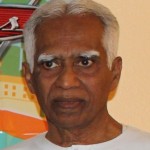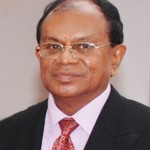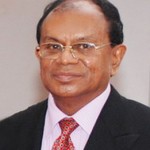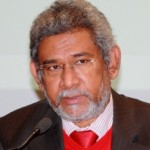–

Jehan Perera
The government’s decision to celebrate May 19 as a day of victory and the country’s second Independence is another one of its actions that has polarised the Sri Lankan people. Whether by accident or design, it is ironic that through its continuing actions the government that reunified the territory of the country should also be the one that fosters the divisions between the people. I was in Mannar on that day that marked a watershed in the modern history of the country, and saw that the Sri Lankan people were divided in their attitudes. There was no collective remembrance of loss, but a reinforcement of the separation that has overshadowed the post-Independence era.
While the government was celebrating with military march pasts and air and sea shows in Colombo, in Mannar there was real action that was reminiscent of what happened during the war. A group of people who had gathered to commemorate those who died in the last battle, were prevented from doing so by armed military personnel and police with guns pointing. It is reported that 15 of them were arrested and only released on bail late at night. Earlier the state media had reported that such commemorative meetings were illegal and warned anyone commemorating the defeated Liberation Tigers of Tamil Eelam (LTTE) was liable to be arrested.
However, the Tamil political parties in the opposition said they staged the remembrance for those who died in the final battle. This was where the top LTTE leadership were killed. In this charged context, the decision of the Catholic Church in Mannar to commemorate all victims of the war was pragmatic. Whenever Tamils have tried to commemorate the death of their loved ones, the government has taken steps to prevent this. The military in particular is sensitive to commemorations of the LTTE being held in the guise of commemorating the civilians who lost their lives. However, the reality is that the two groups of LTTE and civilians were often mixed. Especially in the last days of the war, the LTTE forcibly recruited children, some as young as 12, and this included the children of Mannar.
Contrasting Realities
Mannar is the only one of Sri Lanka’s 25 districts that has a Catholic majority. With its unique cultural attributes, it is a celebration of the country’s cultural and religious diversity which must not be made into a weakness when it is a strength. Unlike the Tamil political parties who had called on the people to commemorate the war dead amongst the Tamil population, the Bishop of Mannar requested the clergy in the area to commemorate all victims of the war, and not just those who were Tamil. By implication, this would have included those of all three ethnic groups, the Sinhalese, Tamils and Muslims, and also the fighting personnel on the two sides, the government and LTTE. It is a testament to the strength of Sri Lanka’s diversity, that it was a minority group that decided to commemorate all who lost their lives as recommended by the Lessons Learnt and Reconciliation Commission appointed by the President.
This year’s victory celebration by the government was focused on the valour of the armed forces and the comprehensive defeat of the LTTE. President Mahinda Rajapakse viewed the military parade and pledged that there will be no room for those who tried to divide the country. He said, “We will not allow a single inch of the land that you won by the sacrifice of your life to be taken away.” The past fortnight saw a build up in the mass media to remind the people of those days of blood and bombs and how it all has ended. The contrast with the peaceful situation of the present will continue to bring in the votes of a grateful nation.
But the unfortunate reality is that the support of the Sinhalese majority for the war victory and the government’s celebrations has not been matched by any kind of equivalent support from the Tamil minority. They too have been beneficiaries of the peaceful situation that has followed the end of the war. They are now safe from the ravages of child recruitment and terror tactics that the LTTE brought to bear upon them. But they also wish to mourn their loved ones who are no more with them, to find out what happened to them, and also to regain their dream of enjoying equal rights in which they also have the right to decide. These are all matters on which the government appointed LLRC has made recommendations on but are not being followed by the government.
Way Forward
Four years after the war’s end the political solution that the leaders of government promised during the time of the war has yet to materialize. The LTTE has been replaced by the Sri Lankan military who govern them in conjunction with the civilian administration. The Northern Province, where the first gunshots of the war were fired and where the last of the rebel fighters fell, has still to enjoy the right of elected provincial governance even to as limited an extent as the other eight provinces do. A government ally has filed action in the Supreme Court calling on it to abolish the system of devolution of power for the entire country. In this context, there is increasing skepticism whether the promised Northern Provincial Council elections in September this year will actually take place.
The civil war ended in 2009 but four years later the country has yet to find its path of reconciliation and to heal the wounds of war. At the present time it also appears that Sri Lanka is moving backwards, and not forwards, in terms of securing the Rule of Law. The impeachment of the Chief Justice process eroded the rule of law and usurped the pre-eminence of the Supreme Court in its role of interpreting the constitution. This has impacted negatively on the rule of law and by extension the protection of human rights and political accountability. There is also the rise of inter-religious tensions fanned by government allies. A new dimension of inter-communal unrest is the rise of Buddhist extremism that has targeted the Muslim community and taken on an open and frontal confrontational approach.
Sri Lanka could have been a very different country today. There is a need to recognize that although the civil war ended in 2009 the country has yet to find its path of reconciliation through an inclusive process of political negotiations and a sincere effort to heal the wounds of war. If the recommendations of the LLRC appointed by the President had been followed, the government could have changed course last year. Government leaders would have ceased to further engage in ethnic triumphalism and instead focused on commemorating all victims who lost their lives in the senseless conflict. They could have utilized the occasion of May 19 to resolve that never again would such bloodletting be permitted to take place. This would have been a commemoration that all Sri Lankans, respecting multi ethnicity, equal rights, and the safety and dignity of all, could have taken part in as a united Sri Lankan nation.










